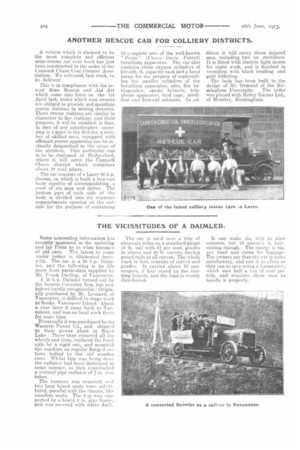ANOTHER RESCUE CAR FOR COLLIERY DISTRICTS.
Page 30

If you've noticed an error in this article please click here to report it so we can fix it.
A vehicle which is claimed to be the most complete and efficient mine-rescue car ever built has just been constructed to the order of the Caxinock Chase Coal Owners' Association. We referred, last week, to its delivery.
This is in compliance with the recent Mine Rescue and Aid Act which came into force on the 1st April last, under which coal owners are obliged to provide and maintain rescue stations in mining districts. These rescue stations are similar in character to fire stations, and their purpose, it will be recalled, is that, in case of any catastrophes occurring in a mine in the district, a number of skilled mcn, equipped with efficient rescue apparatus can be instantly despatched to the scene of the accident. This particular van is to be stationed at Hednesford, where it will serve the Cannock Chase district which comprises about 20 coal mines.
The car consists of a Lacre 30 h.p. chassis, on which is built a box-van body capable of accommodating a crew of six men and driver. The bottom part of each side of the body is divided into six separate compartments opening on the outside for the purpose of containing 12 complete sets of the well-known " Proto " (Fleus.s Davis Patent) breathing apparatus. The car also contains three oxygen cylinders of 100 cub. ft. capacity each and a hand pump for the purpose of replenishing the smaller cylinders of the breathing apparatus, also, fire extinguisher, smoke helmets, telephone apparatus, bird cage, medicine and first-aid cabinets. In ad
dition. it will carry three injured men, including two on stretchers. It is fitted with electric light inside for night work, and is finished in vermilion with black beading and gold lettering.
The body has been built to the design of Mr. Ormond of the Bir mingham University. The order was placed with Henry Garner Ltd., of Moseley, Birmingham.
































